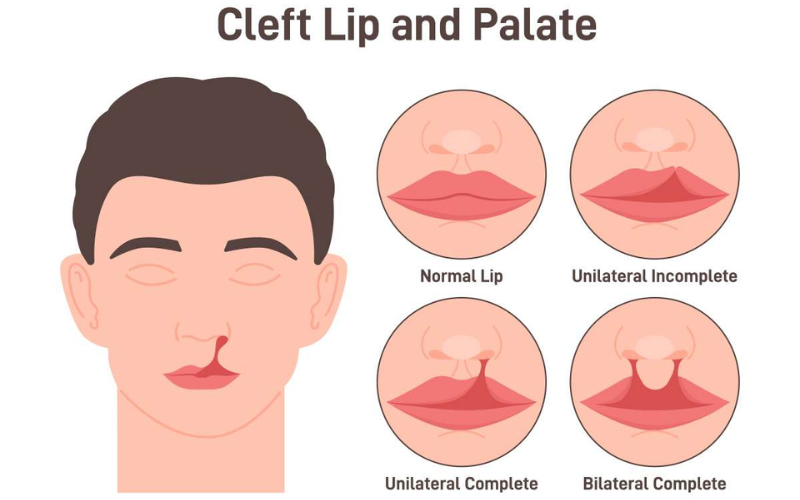509-315-9840
How Does Early Cleft Lip & Palate Treatment Impact Oral Health?

Cleft lip and palate are congenital conditions that affect the formation of a baby’s upper lip and the roof of the mouth. These conditions can cause significant challenges with eating, speaking, and overall facial development.
Early treatment for cleft lip and palate is crucial for improving not only the cosmetic appearance but also the long-term oral health of individuals affected by these conditions.
In this blog, we will explore how early intervention can impact oral health, the benefits of comprehensive care, and why timely treatment is vital for long-term outcomes.
Understand Cleft Lip and Palate
Before diving into the specifics of treatment and its impact, it’s essential to understand what cleft lip and palate are.
- Cleft Lip: A gap or split in the upper lip that can range from a small notch to a large opening extending into the nose.
- Cleft Palate: A gap or opening in the roof of the mouth (palate), which may affect the front, back, or both sections.
These conditions occur early in pregnancy when the tissues forming the lip and palate do not fuse properly. In some cases, a child may have a cleft lip, a cleft palate, or both.
Impact of Early Cleft Lip and Palate Treatment
Early cleft lip and palate treatment directly impacts a child’s oral health, setting the foundation for a healthier future. Below are some key ways in which early intervention influences oral health outcomes:
1. Improved Dental Alignment and Bite
One of the major issues caused by cleft lip and palate is dental misalignment. The gap in the lip or palate can affect how the teeth grow and align, often leading to crooked, missing, or extra teeth. Early surgical intervention, combined with orthodontic treatment, helps guide the proper growth of teeth.
Key benefits
- Better alignment of teeth, reducing the need for extensive orthodontics later in life.
- Improved bite, preventing issues such as malocclusion (misaligned bite).
- Easier speech and chewing, which contribute to better oral function overall.
2. Reduced Risk of Tooth Decay and Gum Disease
Children born with cleft lip and palate are at a higher risk of tooth decay and gum disease, especially if the cleft affects the gumline. This is because the abnormal shape of the mouth can create more areas where food and bacteria can become trapped, leading to plaque buildup. Early treatment helps correct these structural abnormalities and allows for better oral hygiene.
Key benefits
- Easier to maintain good oral hygiene with proper alignment and closure of the lip and palate.
- Reduced risk of cavities and gum infections in the long term.
- Prevention of future dental complications that may require more invasive treatments.
3. Enhanced Speech Development
Cleft lip and palate can interfere with the development of normal speech because the separation in the palate affects the way air flows through the mouth and nose. This leads to difficulties in forming sounds and words correctly. Early surgery to close the cleft significantly improves the chances of normal speech development, which is also crucial for oral health.
Key benefits
- Proper palate structure supports better articulation of sounds.
- Reduced likelihood of needing extensive speech therapy later in life.
- Better coordination of the tongue, lips, and teeth during speech, which supports overall oral function.
4. Improved Facial and Oral Muscle Development
Beyond teeth and speech, the muscles of the face and mouth are also affected by cleft lip and palate. Early surgical correction allows the muscles to develop properly, promoting better oral function. This includes improved chewing, swallowing, and facial expressions, which are important for maintaining a healthy mouth.
Key benefits
- Proper muscle development improves eating and digestion.
- Better control of facial expressions and mouth movements, promoting oral comfort and aesthetics.
- Enhanced coordination of the mouth’s functions, such as sucking, chewing, and swallowing.
Role of Multidisciplinary Care In Cleft Lip and Palate Treatment
Successful early treatment of cleft lip and palate requires a multidisciplinary approach. A team of specialists works together to address the various aspects of children’s development, including their oral health. This team may include:
- Pediatricians and Surgeons: To manage the child’s overall health and perform corrective surgeries.
- Dentists and Orthodontists: To ensure proper dental alignment, treat tooth decay, and guide oral hygiene.
- Speech Therapists: To assist in normalizing speech development.
- Ear, Nose, and Throat (ENT) Specialists: To manage hearing and ear-related complications.
Comprehensive Care Benefits
- Each specialist addresses specific needs, ensuring well-rounded treatment.
- Better coordination among healthcare providers results in more effective long-term outcomes.
- Each child’s personalized treatment plan is created based on the severity of their condition and overall health.
Long-Term Benefits of Early Diagnosis for Cleft Lip and Palate
The long-term oral health outcomes for children who receive early treatment for cleft lip and palate are significantly better than for those who delay or do not receive treatment. Early intervention promotes:
- Healthier Teeth and Gums: With dental alignment and structure corrected early, children are less likely to experience severe oral health issues later in life.
- Fewer Complex Procedures: Early treatment reduces the need for more invasive surgeries and treatments as the child grows.
- Normal Development of Oral Functions: Proper eating, speaking, and facial movements are supported by timely surgical and orthodontic care.
Common Procedures For Its Treatment

The treatment plan for cleft lip and palate typically involves several steps, starting when the child is a few months old. Key procedures include:
- Surgical Repair of Cleft Lip (3-6 months of age): Surgery is performed to close the gap in the lip.
- Surgical Repair of Cleft Palate (6-12 months of age): The cleft in the palate is closed to improve eating, speaking, and overall oral structure.
- Orthodontic Care (Early Childhood to Adolescence): Braces or other orthodontic devices may align teeth as they emerge.
- Ongoing Dental Care: Regular dental visits are essential to maintain oral health and address any issues that arise as the child’s teeth grow.
Early cleft lip and palate treatment is crucial not only for cosmetic and developmental reasons but also for promoting long-term oral health. By addressing these conditions in infancy, children can avoid many of the complications that arise from untreated clefts, such as dental misalignment, speech difficulties, and a higher risk of tooth decay and gum disease.
With a comprehensive treatment plan and multidisciplinary care, children with cleft lip and palate can enjoy healthier teeth, better oral function, and improved quality of life.



